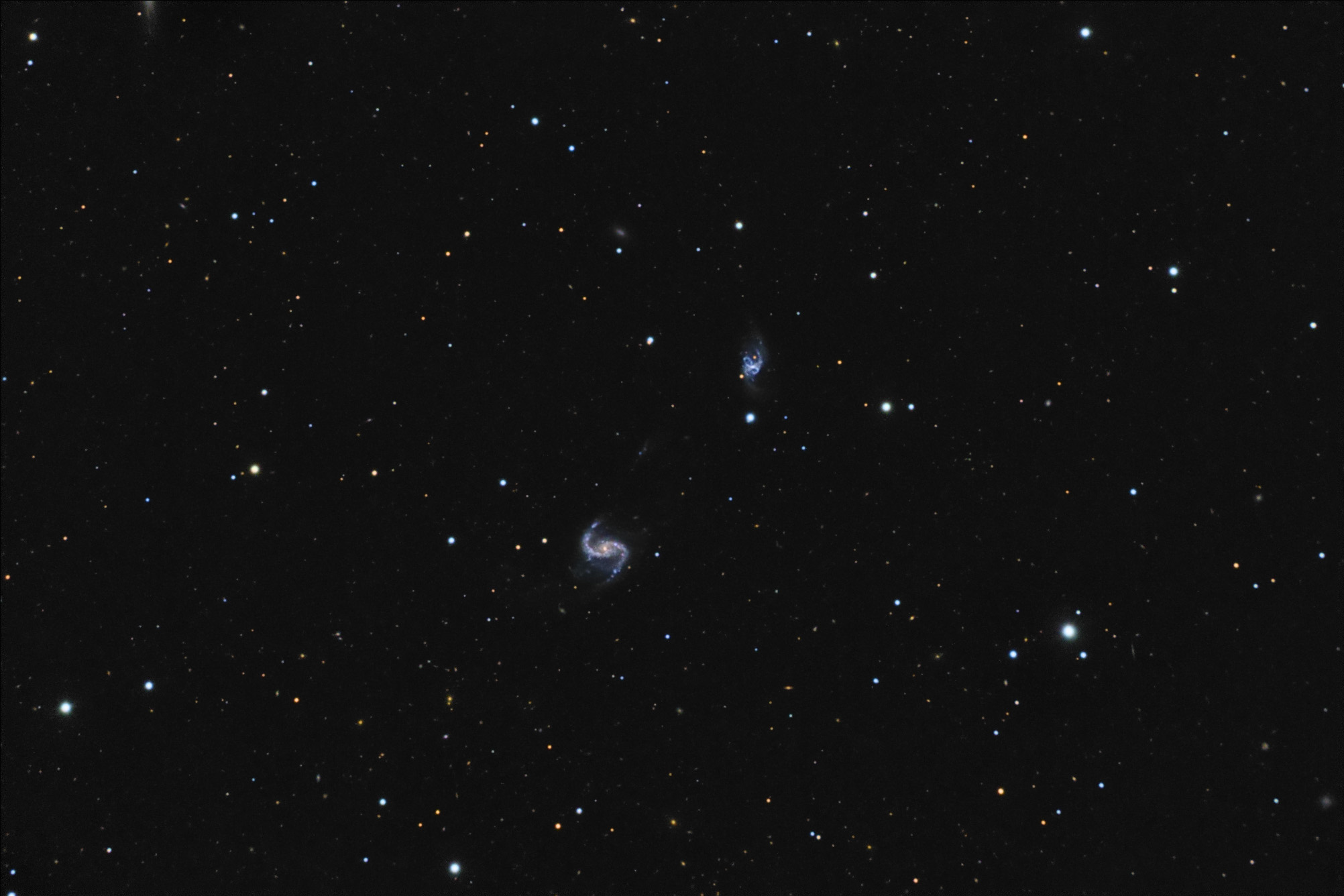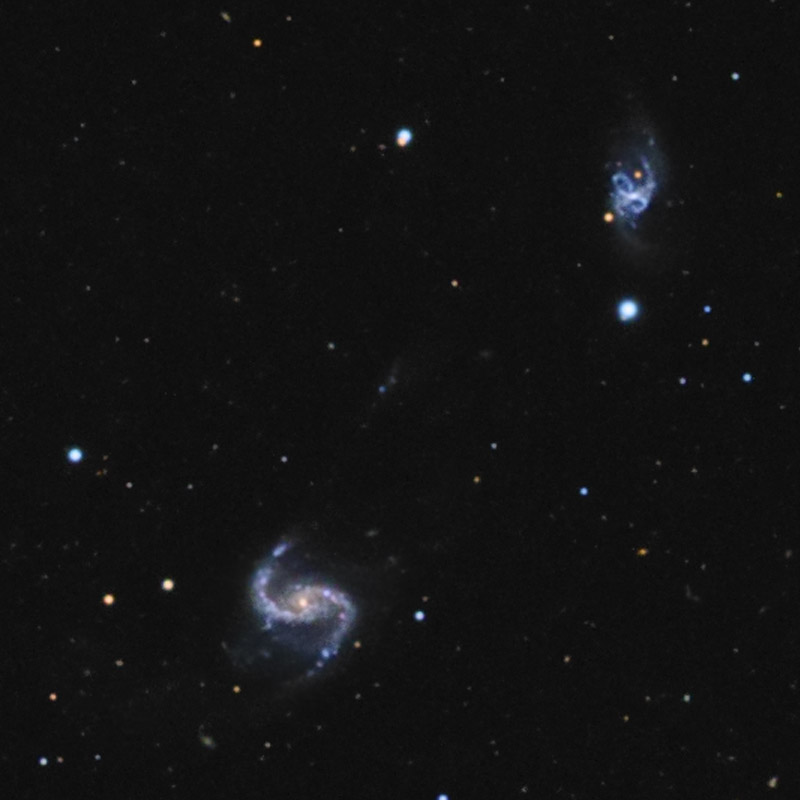Object name: ARP305Designation(s): ARP305, NGC4016, NGC4017, ARP 305 is a pair of galaxies. That's how Arp classified them as well, "Group Character: Double Galaxies. This is the same classification as Arp 303 though this pair is far more interesting. The northern galaxy is NGC 4016. It looks to me as if it has two sets of spiral arms. One set narrow and looping back to the core like a pretzel while the other pair are broad and set at nearly a right angle to the first pair. Both are obviously due to tidal effects of a close encounter, probably with NGC 4017. But explaining their vast difference would seem to me to be a major headache. Could it be two merged or superimposed galaxies? If so, rotational rates would likely be different but since we see it so face on, likely not enough different to be measurable. NGC 4016 is classed by NED as SBdm:. Train-wreck is likely a better classification. One note at NED says of it: "Distorted, patchy, hints of spiral structure in the outskirts". Odd but I thought those arms were rather obvious. Why it isn't classed as peculiar as well I can't fathom. NGC project though does class it SBc-Irr which makes more sense to me.
NGC 4017, while at first appearing more "normal" shows strong signs of interaction with NGC 4016, not the least of which is the faint connection that seems to run from its northern arm up to NGC 4016. Most obvious is the debris almost dead center between them. It seems a bit "windswept" (to use an Arp term) with wisps of stars appearing to have been "blown" northwestward. Arp commented on this filament when he said: "Segment breaking from arm of small galaxy, weak filaments reach to north galaxy, which has figure 8 loops." The detached piece plus the faint piece half way between almost make it look like the northern arm of NGC 4017 is shooting star blobs at its companion. Note too that there's a lot of debris off the southern arm as well that heads nearly due east. I've attached a 150% enlargement of my image that shows this a bit better than the main image. I suppose any residents living on stars orbiting these detached pieces would resent being called debris. NGC 4016 was discovered by R. J. Mitchell on March 30, 1854 while NGC 4017 was seen by William Herschel on April 11, 1785. It isn't in either H400 observing program.
The pair are located about 170 million light-years from us. NGC 4016 is located about 2/3rds of a degree south of the southern border of Ursa Major only a few seconds of arc into Coma Berenices from Leo. About 10 minutes of arc north of my image is the center of the NGC 4008 group. This group is listed in NED to be about 170 million light-years distant. It is likely Arp 305 is part of the group. Not far from its center is NGC 4004 which is also highly distorted and on my list for next spring. It too is 170 million light-years away and may have tangled with Arp 305.
The galaxy northwest of NGC 4016 is MAPS-NGP O_320_0562408. Its redshift indicates a distance of only 40 million light-years. If so, it is a dwarf irregular galaxy.
Well below NGC 4016 and southwest of NGC 4017 is a small lenticular like, very red galaxy. It is SDSS J115824.86+272340.4 at just under 2 billion light-years. West of it is a blue star, angle up a bit from it toward the very bright blue star, about one third of the way you come to a smaller reddish galaxy, it too is 2 billion light-years away. It is not an IR galaxy like the previous one was and not as red. It is SDSS J115808.00+272428.4.
Southeast of NGC 4017 are two short dashes with a gap between them. This is the asteroid (84842) 2003 AS17 at magnitude 19.1. I took color data between two 20 minute luminosity imaging runs. That created the gap as there's nothing for the color data to color in the gap. Below the western end of the western trail is a very red spherical galaxy. It is SDSS J115903.15+272321.9 and is also just under 2 billion light-years from us. There are quite a few other galaxies in the lower part of the frame that are at this 2 billion light year distance. 2 minutes of arc below the south edge of the image almost on its centerline is the galaxy cluster MaxBCG J179.60472+27.27528 with 22 members per NED. Its distance is listed as, you guessed it, just under 2 billion light-years. With no size given for it, I can't tell if the 2 billion light-years distant galaxies in my image are part of the group or not. It seems likely, however.
The fuzzy galaxy in the lower right corner is MAPS-NGP O_320_0562408.
SDSS image
http://astronomerica.awardspace.com/SDSS-30/NGC4016.php
http://astronomerica.awardspace.com/SDSS-30/NGC4017.php
Arp's image
http://ned.ipac.caltech.edu/level5/Arp/Figures/big_arp305.jpeg
14" LX200R @ f/10, L=4X10' RGB=2X10', STL-11000XM, Paramount ME Related Designation(s):2MASS J11582907+2731433, 2MASS J11584566+2727087, 2MASX J11582910+2731431, 2MASX J11584562+2727084, 2MASXi J1158291+273143, 2MASXi J1158456+272709, AKARI J1158458+272708, ARP 305, ARP 305 NED01, ARP 305 NED02, ARP305, ASK 572810.0, ASK 574221.0, CGCG 1155.8+2748, CGCG 1156.1+2743, CGCG 157-068, CGCG 157-069, ECO 03221, ECO 03226, HDCE 0686 NED004, IRAS 11561+2743, IRAS F11559+2748, IRAS F11561+2743, KUG 1155+278, KUG 1156+277, LDCE 0855 NED004, LGG 262:[G93] 003, LGG 262:[G93] 004, MAPS-NGP O_320_0538364, MCG +05-28-063, MCG +05-28-065, NGC 4016, NGC 4017, NGC4016, NGC4017, NSA 102193, NSA 102480, NVSS J115828+273144, NVSS J115834+272916, NVSS J115845+272709, PGC 037687, PGC 037705, SDSS J115829.01+273143.6, SDSS J115829.02+273143.6, SDSS J115845.66+272708.7, SDSS J115845.67+272708.7, SDSS J115845.67+272708.8, UGC 06954, UGC 06967, USGC U435 NED01, USGC U435 NED02, UZC J115829.0+273144, UZC J115845.8+272710, VV 424, [KG2002] J115829.00+273144.0 , [KG2002] J115845.83+272709.7 , [M98j] 151 NED03, [TTL2012] 320135, [TTL2012] 332742, | | 
